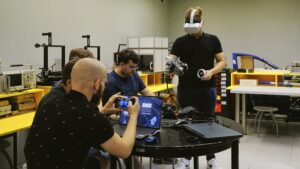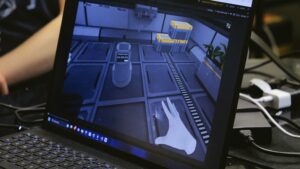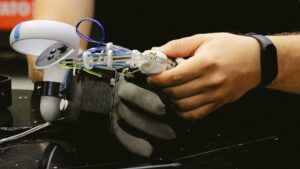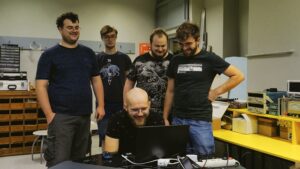Start - Aktualności - To Touch VR
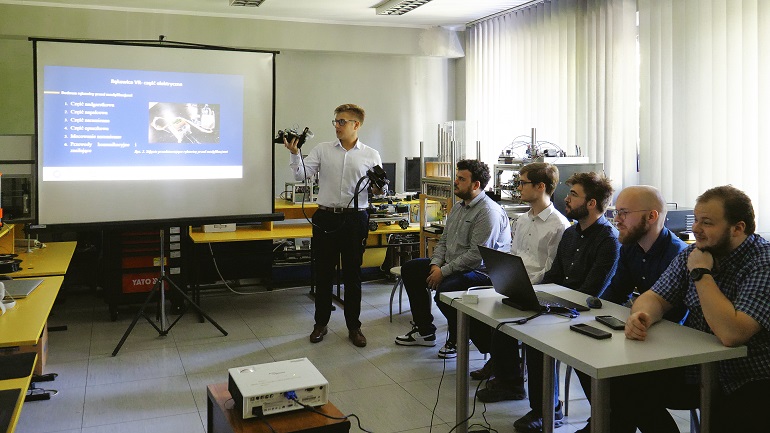
To Touch VR
VR goggles allow us to perceive virtual reality using sight, hearing, and sense of balance, but how to immerse ourselves even deeper into the virtual world by complementing these senses with touch? This question was asked by students of the Silesian University of Technology, who developed a tactical glove that allows users to feel virtual elements. Another group working on this project went a step further and created an engineering VR game.
You are a member of a crew that flies to Mars. Unfortunately, your spaceship suffers an accident and in order to get out of the oppression you have to fix it – this is an outline of the game plot created entirely by students of Mechatronics at the Silesian University of Technology. The player must show off not only his dexterity, but also basic engineering knowledge to properly fix all the broken spacecraft systems. On the head - VR goggles, on the hand - a special tactical glove, a prototype, which was created thanks to the work of two teams of students, as part of two editions of Project Based Learning projects.
– I did not expect that the effect would be so impressive – Dr Eng. Paweł Kowol from the Department of Mechatronics of the Faculty of Electrical Engineering, the supervisor and originator of the first project cannot stop praising his pupils. – This is the third PBL project on this topic. The first team developed the tactical part of the glove, the second translated the movement of fingers into contact with VR – these were the beginnings of a virtual environment. The current team focused on developing aspects related to virtual reality.
The students began with a brainstorming session, during which they agreed that by controlling the tactical glove they would lay mechatronic blocks in a virtual world, which would allow to show the operation of the glove and the fact that thanks to it one can feel individual virtual elements. However, the ambitious group quickly came to the conclusion that their idea would be enriched by the story layer and thus the idea of a mission to Mars was born. Young people began to create their own game, using not only theoretical knowledge, but also developing their previous interests.
– I have been interested for a long time in how games are made, so the tool we used, the Unity engine, was already quite well known to me – says Paweł Misztal in the game design team. – We decided to use the Low poly style, which is quite simple, and what is more, some ready-made models can be purchased online. We used one such set to build our spacecraft. We expanded the game ourselves by adding new elements and mechanics that we wanted to implement in the game.
The result of the students’ work is a full-fledged VR game, which could be successfully placed, for example on a Steam service. To control the game, instead of a pad, a tactical glove is used, that is, engaging touch in the perception of virtual reality.
– The glove allows the user to touch virtual reality, the elements of which are not only observable, but become tangible – explains Dr Eng. Pawel Kowol. – When we grab something in virtual reality, the locking system in the tweezer grip blocks the index finger and thumb at some point and we feel resistance. Under the fingertips there are cushions with magnetorheological liquid, changing its viscosity in the magnetic field, thanks to which we feel a change in hardness when gripping. The combination of the finger stop system with the magnetorheological liquid excitation system is an innovative solution.
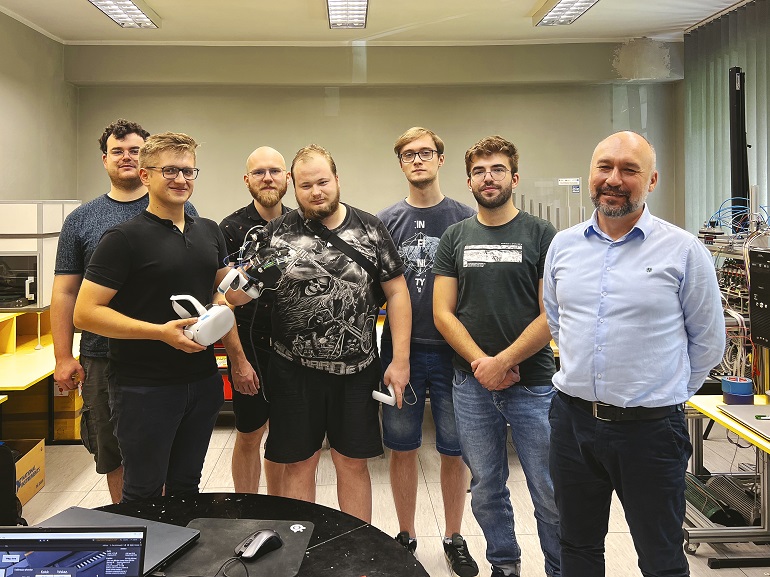
From the left: Szymon Nocoń, Mateusz Soboniak, Paweł Misztal, Kamil Nędza, Błażej Siejka, Dominik Berger, dr inż. Paweł Kowol
– I am very happy with the results of our work, I was also relieved to some extent that it was successful, because it was a really big project – says Mateusz Soboniak, responsible for the electrical part related to the VR glove. “We are the third team to work on the glove. We wanted to improve the comfort of using our prototype, and in addition to creating a game with an educational aspect, we also added a research aspect – we can check the influence of the magnetic field on the force measurement sensors.
The work of the team took place under the watchful eye of lecturers from various faculties of the university, as well as with the help of an expert from outside, advising young people on how to deal with issues related to VR. Such a teaching model is a challenge not only for students, but also for teachers.
– Practical knowledge cannot be fully communicated during lectures or workshops – emphasizes Dr Eng. Wacław Banaś from the Faculty of Mechanical Engineering, tutor of students during the project implementation. – During the course of conducting the classes, nothing surprises me, everything is developed, and at the same time the work on this project was associated with a kind of mystery. Sometimes students surprised me with a question, and I had to make an effort to answer them. However, in this way classes are much better conducted because the sight of students enjoying learning gives the lecturer a great pleasure. During lectures I sometimes have the impression that some people listen, some do not, but here the information was absorbed easily – he adds.
Students also confirm their enthusiasm for work. As part of the PBL project, they spent incomparably more time in order to earn 15 ECTS credits than if they had attended regular classes.
– That is right, I often worked on a project at home, even when I did not have to, I just could not wait to solve a problem – Paweł Misztal confirms the lecturer’s comments. – The result gives incredible satisfaction; I am proud to have taken part in this project.
– The impressions are shocking, especially the amount of work that students put into this interdisciplinary project – says Dr Eng. Dariusz Buchczik from the Faculty of Automatic Control, Electronics and Computer Science. PBL projects are based on interdisciplinarity and student-oriented teaching, unlike the way in which a teacher transmits knowledge ex cathedra. Here students learn to solve problems themselves, and the teacher helps them get through them.
The result of this way of teaching, or rather scientific cooperation, is not only an engineering game with a tactical glove, but also valuable experience gained by the participants of the PBL project.
– I was pleased to see them come across some technical nuances that they would not have encountered in class, how they learned to solve them. The acquired skills, such as working in a group, adapting to time constraints, are values that they will not gain in the framework of traditional education, and this will certainly pay off in the future – adds Dr Eng. Kowol.
The lecturer encourages students to be proud about the effects of their work, especially as ambitious project as this one. In turn, students see further opportunities for the development of the project, such as expanding the game. It is therefore likely that work on the project will continue in the future.





